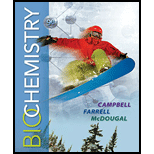
Concept explainers
RECALL How does the catalytic effectiveness of enzymes compare with that of nonenzymatic catalysts?
Interpretation:
The comparison between the catalytic effectiveness of the enzyme and the nonenzymatic catalysts.
Concept introduction:
The process through which the rate of a chemical reaction is increased is termed as catalysis. The functional proteins and some self-splicing ribonucleic acid molecules serve to increase the rate of a reaction and they are known as catalysts. In the biological system, they are known as enzymes.
Enzymes are largely organic in nature and are produced by the organism’s body itself, while catalysts can be organic or inorganic in nature. The catalysts and enzymes are not used up in the chemical reaction, they just alter the rate of the reaction.
Answer to Problem 1RE
The enzymatic catalysts are mainly proteins and some RNA molecules that show higher catalytic activity in terms of specificity, the speed of the reaction than nonenzymatic catalysts, which are organic or inorganic molecules.
Explanation of Solution
The difference between the enzymatic catalysts and nonenzymatic catalysts are as follows:
| Enzymatic catalyst | Nonenzymatic catalyst |
| The enzymatic catalysts are complex proteins and speed up the chemical reactions that occur in the biological system. | The nonenzymatic catalyst increases or decreases the rate of chemical reactions that occur outside the biological system. |
| The enzymatic catalysts are highly specific in nature. | The nonenzymatic catalysts are not very specific in nature. |
| The enzymatic catalysts increase the rate of reaction by an order of 1020. | The nonenzymatic catalysts are comparatively slower and increase the rate of reaction about 102 to 104 times. |
| The enzyme catalyst requires optimum physiological conditions. | The nonenzymatic catalysts require high temperature or pressure. |
Therefore, it can be concluded that the catalytic effectiveness of the enzymatic catalyst is higher than that of a nonenzymatic catalyst. The enzymatic catalyst is more specific in nature than the nonenzymatic catalyst.
Want to see more full solutions like this?
Chapter 6 Solutions
Biochemistry
- The following data were recorded for the enzyme catalyzed conversion of S -> P. Question: Estimate the Vmax and Km. What would be the rate at 2.5 and 5.0 x 10-5 M [S] ?arrow_forwardPlease helparrow_forwardThe following data were recorded for the enzyme catalyzed conversion of S -> P Question: what would the rate be at 5.0 x 10-5 M [S] and the enzyme concentration was doubled? Also, the rate given in the table is from product accumulation after 10 minuets of reaction time. Verify these rates represent a true initial rate (less than 5% turnover). Please helparrow_forward
- The following data was obtained on isocitrate lyase from an algal species. Identify the reaction catalyzed by this enzyme, deduce the KM and Vmax , and determine the nature of the inhibition by oxaloacetate. Please helparrow_forwardIn the table below, there are sketches of four crystals made of positively-charged cations and negatively-charged anions. Rank these crystals in decreasing order of stability (or equivalently increasing order of energy). That is, select "1" below the most stable (lowest energy) crystal. Select "2" below the next most stable (next lowest energy) crystal, and so forth. A B 鹽 (Choose one) +2 C +2 +2 (Choose one) D 鹽雞 (Choose one) (Choose one)arrow_forward1. Draw the structures for the fats A. 16:2: w-3 and B. 18:3:49,12,15 2. Name each of the molecules below (image attached)arrow_forward
- draw the structures for the fats A. 16:2:w-3 B 18:3:9,12,15arrow_forward1. Below is a template strand of DNA. Show the mRNA and protein that would result. label the ends of the molecules ( refer to attached image)arrow_forwardAttach the followina labels to the diagram below: helicase, single stranded binding proteins, lagging strand, leading strand, DNA polymerase, primase, 5' ends (3), 3' ends (3) (image attached)arrow_forward
- 1. How much energy in terms of ATP can be obtained from tristearin (stearate is 18:0) Show steps pleasearrow_forwardMultiple choice urgent!!arrow_forward1. Write the transamination reaction for alanine. Indicate what happens next to each of the molecules in the reaction, and under what conditions it happens. 2.arrow_forward
 BiochemistryBiochemistryISBN:9781305961135Author:Mary K. Campbell, Shawn O. Farrell, Owen M. McDougalPublisher:Cengage Learning
BiochemistryBiochemistryISBN:9781305961135Author:Mary K. Campbell, Shawn O. Farrell, Owen M. McDougalPublisher:Cengage Learning
